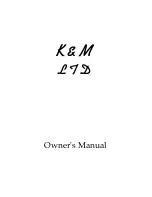
Minor Triad
The second note in the C major scale is D from which the Dorian mode is
derived. When we choose the first, third, and fifth notes of this mode we get a
different-sounding chord from the major. Here the interval from D to F is a minor
third (1½ steps) and the interval from F to A is a major third (2 steps). This
arrangement of intervals produces a minor chord.
When we add the seventh note of the mode, we create a four-note chord known
as a
minor 7th.
The other modes in the diatonic scale that produce a minor chord are Phrygian
and Aeolian. In the key of C major they look like this:
The Aeolian mode is also known as the
natural minor
scale. The Aeolian mode
is also refered to as the
relative minor
key of the major key from which it is
derived.
In the example below, the A Aeolian mode is the natural minor scale relative to C
major scale.
1
2
3
4
5
6
7
8
D
w
w
h
w
w
w
h
D
E
F
G
A
B C
1
2
3
4
5
6
7
8
E
w
w
h
w
w
w
h
E
F
G
A
B
C
D
1
2
3
4
5
6
7
8
A
w
w
h
w
w
w
h
A
B C
D
E
F
G
Aeolian Mode
Dorian Mode
Phrygian Mode
Em7
Am7
Dm7
{
Minor 3rd
{
Major 3rd
{
Minor 3rd
15
















































